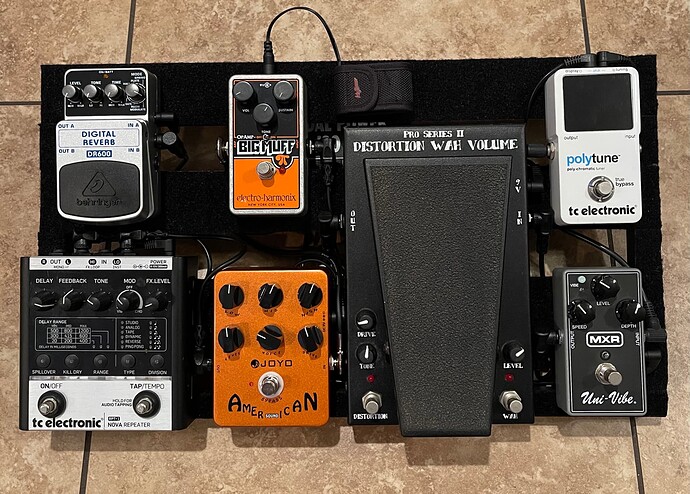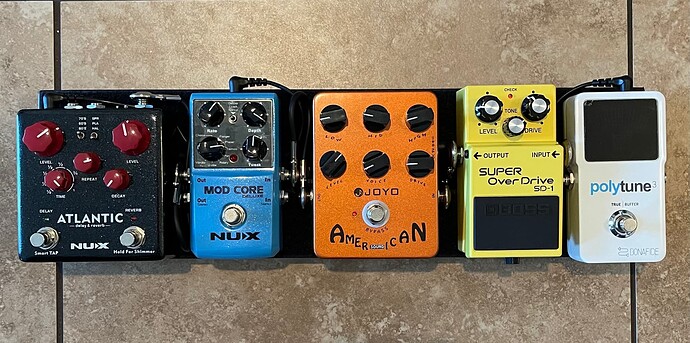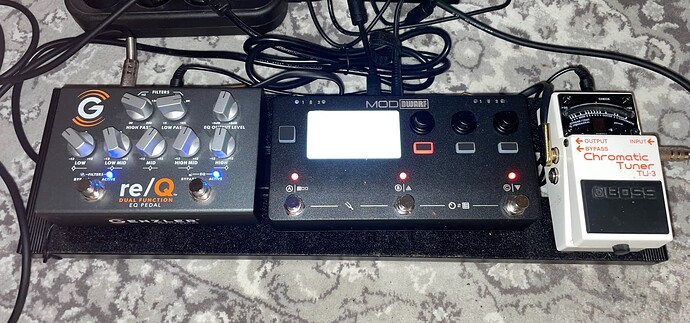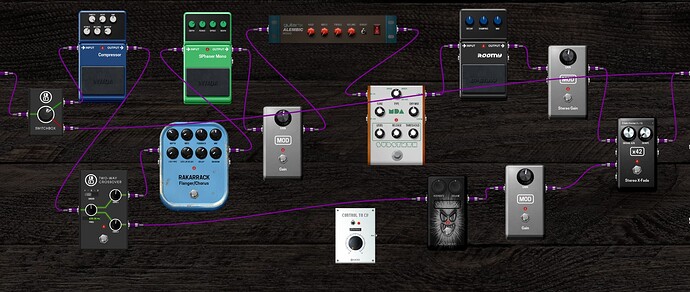@Wombat-metal, Yeah it looks like a good one.
I think this might be the right place to share this. For those of us who have to practice and play at very low volumes (in an apartment and alike) and never get to hear gain or saturated sound, the Joyo California Amp Simulator pedal is an inexpensive and fun pedal. Two more options are available (British and American). There are probably much better ones out there but these seem to be a cheap and fun alternative. Enjoy!
Joyo typically punches above its weight in the inexpensive market as far as I can tell. They even show up at NAMM. And gave me a custom Joyo pick with my compressor XD.
JHS even has a YouTube video reviewing and recommending them, too.
I did some research on the topic and I’m really happy with it. That’s why I wanted to share it since it seems to me like a really good product at a good price. I’ve heard many good reviews about Joyo.
I’ve got the American Sound on two different boards. The Singing Bassman setting works great for both guitar and bass. Very happy for the price.
Interesting to see where you placed it in both cases. So far I have only tried it out at the end of the chain before the amp. Do you have a reason to do so? Comments and suggestions welcome!
I typically play into my Rumble 500 or direct into the DI when I play live, depending on what’s called for. I basically set mine up like a pre-amp, and I wanted the drive tone I create to feel like it has space and dimension. That’s why the modulation after. It is an always on pedal for me. Set for Edge of breakup at full volume that way any other drives pushing it will still respond to the volume knob. Especially the fuzz. Can almost walk away from the board unless I need to tap a tempo in or drop the reverb for a melody that needs to punch through.
@Reasonably_Happy Thank you so much for the input. That makes a lot of sense, particularly the volume reasoning. Without any experience my logic was that I ought to see the pedal as a replacement for the mike before the amp.
My setting is a desk with the laptop, DI and pedals, sound monitors and a small Laney RB2 under the desk. Either I hear myself through the amp (after pedals) at low volume (no DI) which sounds like an amp at very low volume, no gain. That’s were the pedal comes in and it sounds “loud” at low volume.
When I use headphones I go through the same chain into the amp at 0 volume going into the DI into GarageBand and I can take lessons at the same time. Seems to work without having to unplugging things to change from one to the other.
Anyway, I should give your reasoning a try by putting it first before everything else including the preamp since it has compression, distortion and gate built in. Cool! Thanks!
Smart idea!!
Reviving this thread, but perhaps I’d better post this somewhere else!?!
Re-did my pedalboard and removed my UA pedals (for now) and the booster pedal and instead added the MOD Dwarf and the Genzler re/Q:
Probably not many with a Dwarf in here!? @mediaklan perhaps (IIRC)?
It’s an interesting device, promoting more open-source, user-definable features and development. I made a virtual pedalboard that really has me covered for now, while leaving plenty of room for experimentation. It also recently started to offer the possibility to include an AI modeller (Aida-X) to incorporate amp models etc.
Anyway, I felt like it was time to change things up a bit ![]()
Back then I decided on a multieffect pedal, I considerered it when I found out about it. Found it really interesting for its Open Source approach.
In the end it was the Boss GT-1000Core for me, one reason back then was its availability and also that it was the one with the least power requirements and can be powered by the power supply of my pedal board with all the other pedals. The Helix Stomp would have had to use its own power supply, and I think the Dwarf too.
And probably the biggest reason is because my mind was kinda made up on the Boss at the time I found the Dwarf.
Yes, it does (kinda… there are reports about people getting away with smaller power supplies). But, yes, this means I need to find space on the board for this extra power supply. No big deal, though… ![]()
The dwarf is indeed an incredible device. I’ve spent hours (still am) trying things. This is clearly a device for the tinkerers. For now I’m still creating different pedalboards just from the web gui to see where it goes (learning about the plugins, tried some things with AIDA-X), and I’m still not really familiar with the physical interface itself (it’s easy enough to use anyway, so some things are learned quite fast).
Just the ability to share pedalboards is fascinating by itself…
I’m counting on you @joergkutter ![]() !
!
Haha, yeah, well, let’s see… I have made a fairly OK board to start off with (after some tinkering, of course) ![]() If you go to the pedalboard feed on the MOD forum, you should see it as the top one (latest addition).
If you go to the pedalboard feed on the MOD forum, you should see it as the top one (latest addition).
I use some signal splitting to preserve bottom end, and boosting together with some of the effects (including a real boost with a bit of fuzz for solo etc) - take a look and ask me if you are in doubt about what the idea was ![]()
It’s more or less optimized for an active jazz (my Mayones) as input and I also use an extra EQ (see pic further up) to tweak the final things about the overall sound. I think other basses might benefit from slightly different approaches. And, of course, it depends on what type of tone you are going for overall. This one I shared is fairly clean.
Let me know if you have some cool effects or plug-ins you are trying on the Dwarf!
I’m looking forward to hearing how the MOD Dwarf works out. It looks like a fun platform to play with. I’m curious about the quality of the effects modules and @joergkutter has the perfect test platform. Do you find ones that sound good compared to the UA?
Too early to make an firm conclusions, @DaveT , but what I have tried so far were absolutely decent effects. My problem with the UAs was/is that I a) am not adventurous enough to really push them to their limits (i.e., not really interested in deep space kind of reverbs etc.), and b) that they only remember two settings.
This is all a bit easier on the Dwarf. For “playing around”, there is a web interface, so I can do that while the pedal is on my board below the desk. And, you can make snap-shots of the entire board (apart from saving user presets per individual effect) to quickly switch between “normal” and “far out” settings.
So far, I like the chorus, flanger and reverb I found, and also the compressor. There is an OK octaver and fuzz as well that I have tried. I don’t have a good comparison for the compressor, other than the LA-2A as a DAW plugin, but the one I use on the Dwarf does a fine job (for my playing style). It also took some “mental adjustment” for me, but you can actually try out all the many guitar effects (much more than specifically made for bass), as long as you use a frequency splitter to preserve the low end (say, below 300Hz) and only put the effects on the upper part of the frequency range. And, of course, I can play through guitar amps and cabs with impunity ![]()
Ultimately, the fate of the Dwarf might be governed by how strong the company behind it is (MOD Devices) and how supportive the community is (with making new plug-ins and providing amp captures and cab profiles etc.). The HX Stomp is the slicker overall package for sure, but the Dwarf has more flexibility (as far as I can tell), e.g., with utilizing MIDI for controlling lots of different gear, and having voltage outputting virtual devices for, yep, controlling all kinds of stuff (that you certainly know much more about than I do!). I use this so far to activate two virtual pedals with one physical foot switch, such that I get a bit of boost when (and only when) I switch on a chorus effect. This could probably be done via a parallel signal path as well, but it’s cool to have several options.
The routing possibilities are almost endless and I don’t care too much about the sequence of effects in the signal chain that dogma might dictate - it’s easily changed if I don’t like how it sounds. The limit of routing and how many virtual devices you can have is ultimately given by the CPU load of your virtual pedal board.
Anyway, too early to come with more conclusive statements, but… I like it so far!!
I’ ve just tried your virtual pedalboard (JPK_02 I guess ?).
Seems a little more than a fairly OK board to me ^^, quite fun to try and tweak I might add.
A little question for it : how do you enable the rakarrack flanger/chorus ? I can see it linked to CV > modulation, but have no idea how this works ?
Glad you like it and that it gives you a starting point for further exploration!
The modulation plug-in (Rakkarack) is activated by one of the foot switches on the Dwarf - I think 2nd page, switch two. The first knob on that page is assigned to let you choose between different chorus of flanger settings. I am not sure whether my presets made it into the shared board, but I have a chorus and a flanger as the top two choices, so by rotating the knob you can choose what effect you want.
The CV is to activate the gain pedal right “behind” it whenever I activate the Rakkarack - so, no extra button/switch needs to be pushed. I do this because the chorus/flanger takes a bit of volume away and I compensate with the gain pedal.
(The CV is that white pedal that is seemingly not attached to anything, but it creates a link between the Rakkarack and the gain next to it).
Nice ! And thanks, I will look into it.
Sorry, maybe this is helpful for anyone reading along:
That’s how the virtual board looks on the web interface. The wiring is a bit messy
By the way, @mediaklan, the first plug-in serves as a by-pass for the entire board (if so desired).






